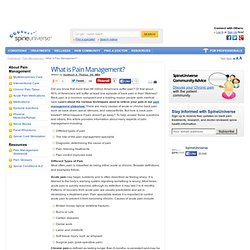

Pain management. Arthritis What is Arthritis?

Learn about how to manage the aches and pains. Key Terms: Acute, Chemotherapy, Chronic, CNS or central nervous system, Hepatic capsule, Iatrogenic, Metastasis, Neuropathy, Neurotransmitter, Nociceptor, Non-pharmacological, Palliative, Pharmacological, PNS or peripheral nervous system, Radiation, Stimulus. Definition Pain management in cancer care encompasses all the actions taken to keep people with cancer as free of pain as possible.
It includes pharmacological, psychological, and spiritual approaches to prevent, reduce, or stop pain sensations. Purpose It is estimated that more than 800,000 new cases of cancer are diagnosed each year in the United States, and 430,000 cancer victims will die. Once the message of cancer has been received and interpreted by the brain, further pain can be counter-productive. Several independent studies of the relief of pain have shown that pain is often under-treated by the medical profession. Description. Pain management. Medicine treats injury and pathology to support and speed healing; and treats distressing symptoms such as pain to relieve suffering during treatment and healing.

When a painful injury or pathology is resistant to treatment and persists, when pain persists after the injury or pathology has healed, and when medical science cannot identify the cause of pain, the task of medicine is to relieve suffering. Treatment approaches to chronic pain include pharmacological measures, such as analgesics, tricyclic antidepressants and anticonvulsants, interventional procedures, physical therapy, physical exercise, application of ice and/or heat, and psychological measures, such as biofeedback and cognitive behavioral therapy. Medical specialties[edit] Pain can either be managed using pharmacological or interventional procedures. There are many interventional procedures available for pain. Pain management practitioners come from all fields of medicine.
Physical approach[edit] TENS[edit] Acupuncture[edit] Pain Management Information by MedicineNet. Pain...Oh, What a Pain!

Medical Author: William C. Shiel, Jr., MD, FACP, FACR Pain is an unpleasant sensation in animals that is caused by actual or perceived injury to body tissues and produces physical and emotional reactions. Presumably, pain sensation has evolved to protect our bodies from harm by causing us to perform certain actions and avoid others. Pain might be called a protector, a predictor, or simply a hassle. We all experience pain to greater or lesser degrees at various points of our lives.
Our individual pain perception can vary at different times, even in response to the identical stimulus. What is Pain Management. Did you know that more than 86 million Americans suffer pain?

Or that about 80% of Americans will suffer at least one episode of back pain in their lifetimes? Back pain is a common complaint and a leading reason people seek medical care. Learn about the various techniques used to relieve your pain in our pain management slideshow. There are many causes of acute or chronic back pain such as back strain, spinal stenosis, and osteoarthritis. But how is back pain treated? Different types of pain The role of the pain management specialist Diagnosis; determining the cause of pain Pain relieving treatments Pain control improves lives Different Types of Pain Most often, pain is classified as being either acute or chronic.
Acute pain may begin suddenly and is often described as feeling sharp. Broken bones (spinal vertebral fracture) Burns or cuts Certain diseases Dental work Labor and childbirth Soft tissue injury, such as whiplash Surgical pain (post-operative pain)